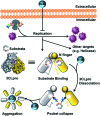Allosteric inhibition of SARS-CoV-2 3CL protease by colloidal bismuth subcitrate
- PMID: 34760193
- PMCID: PMC8565384
- DOI: 10.1039/d1sc03526f
Allosteric inhibition of SARS-CoV-2 3CL protease by colloidal bismuth subcitrate
Abstract
The SARS-CoV-2 3-chymotrypsin-like protease (3CLpro or Mpro) is a key cysteine protease for viral replication and transcription, making it an attractive target for antiviral therapies to combat the COVID-19 disease. Here, we demonstrate that bismuth drug colloidal bismuth subcitrate (CBS) is a potent inhibitor for 3CLpro in vitro and in cellulo. Rather than targeting the cysteine residue at the catalytic site, CBS binds to an allosteric site and results in dissociation of the 3CLpro dimer and proteolytic dysfunction. Our work provides direct evidence that CBS is an allosteric inhibitor of SARS-CoV-2 3CLpro.
This journal is © The Royal Society of Chemistry.
Conflict of interest statement
There are no conflicts to declare.
Figures





Similar articles
-
Catalytic Dyad Residues His41 and Cys145 Impact the Catalytic Activity and Overall Conformational Fold of the Main SARS-CoV-2 Protease 3-Chymotrypsin-Like Protease.Front Chem. 2021 Jun 24;9:692168. doi: 10.3389/fchem.2021.692168. eCollection 2021. Front Chem. 2021. PMID: 34249864 Free PMC article.
-
Ligand-induced Dimerization of Middle East Respiratory Syndrome (MERS) Coronavirus nsp5 Protease (3CLpro): IMPLICATIONS FOR nsp5 REGULATION AND THE DEVELOPMENT OF ANTIVIRALS.J Biol Chem. 2015 Aug 7;290(32):19403-22. doi: 10.1074/jbc.M115.651463. Epub 2015 Jun 8. J Biol Chem. 2015. PMID: 26055715 Free PMC article.
-
Key Allosteric and Active Site Residues of SARS-CoV-2 3CLpro Are Promising Drug Targets.Biochem J. 2023 May 31:BCJ20230027. doi: 10.1042/BCJ20230027. Online ahead of print. Biochem J. 2023. PMID: 37254750
-
Potential 3-chymotrypsin-like cysteine protease cleavage sites in the coronavirus polyproteins pp1a and pp1ab and their possible relevance to COVID-19 vaccine and drug development.FASEB J. 2021 May;35(5):e21573. doi: 10.1096/fj.202100280RR. FASEB J. 2021. PMID: 33913206 Free PMC article. Review.
-
Biflavonoid as potential 3-chymotrypsin-like protease (3CLpro) inhibitor of SARS-Coronavirus.Results Chem. 2021 Jan;3:100087. doi: 10.1016/j.rechem.2020.100087. Epub 2020 Dec 25. Results Chem. 2021. PMID: 33520632 Free PMC article. Review.
Cited by
-
Recent Advances on Targeting Proteases for Antiviral Development.Viruses. 2024 Feb 27;16(3):366. doi: 10.3390/v16030366. Viruses. 2024. PMID: 38543732 Free PMC article. Review.
-
Interaction of copper potential metallodrugs with TMPRSS2: A comparative study of docking tools and its implications on COVID-19.Front Chem. 2023 Jan 26;11:1128859. doi: 10.3389/fchem.2023.1128859. eCollection 2023. Front Chem. 2023. PMID: 36778030 Free PMC article.
-
Discovery of a nasal spray steroid, tixocortol, as an inhibitor of SARS-CoV-2 main protease and viral replication.RSC Med Chem. 2024 Sep 27;15(12):4193-205. doi: 10.1039/d4md00454j. Online ahead of print. RSC Med Chem. 2024. PMID: 39371432 Free PMC article.
-
Regulation of Retroviral and SARS-CoV-2 Protease Dimerization and Activity through Reversible Oxidation.Antioxidants (Basel). 2022 Oct 18;11(10):2054. doi: 10.3390/antiox11102054. Antioxidants (Basel). 2022. PMID: 36290777 Free PMC article. Review.
-
Biological Activities of Bismuth Compounds: An Overview of the New Findings and the Old Challenges Not Yet Overcome.Molecules. 2023 Aug 7;28(15):5921. doi: 10.3390/molecules28155921. Molecules. 2023. PMID: 37570891 Free PMC article. Review.
References
-
- Zhou P. Yang X.-L. Wang X.-G. Hu B. Zhang L. Zhang W. Si H.-R. Zhu Y. Li B. Huang C.-L. Chen H.-D. Chen J. Luo Y. Guo H. Jiang R.-D. Liu M.-Q. Chen Y. Shen X.-R. Wang X. Zheng X.-S. Zhao K. Chen Q.-J. Deng F. Liu L.-L. Yan B. Zhan F.-X. Wang Y.-Y. Xiao G.-F. Shi Z.-L. Nature. 2020;588(7836):E6. doi: 10.1038/s41586-020-2951-z. - DOI - PMC - PubMed
-
- Jin Z. Du X. Xu Y. Deng Y. Liu M. Zhao Y. Zhang B. Li X. Zhang L. Peng C. Duan Y. Yu J. Wang L. Yang K. Liu F. Jiang R. Yang X. You T. Liu X. Yang X. Bai F. Liu H. Liu X. Guddat L. W. Xu W. Xiao G. Qin C. Shi Z. Jiang H. Rao Z. Yang H. Nature. 2020;582(7811):289–293. doi: 10.1038/s41586-020-2223-y. - DOI - PubMed
LinkOut - more resources
Full Text Sources
Other Literature Sources
Miscellaneous

